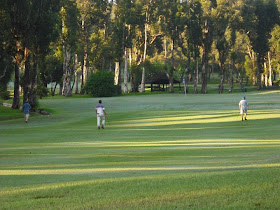Land ownership in Hong Kong is very different than compared to the States. Here, land is owned by the Government and leased by the HKGC from the Government. Even though the club rents the land, the villagers are still entitled to use it. The land is used by the villagers for two main reasons: Golf and Burial Grounds.
Every morning villagers are allowed to “play” the courses using one club and one ball from daybreak until 7:30 A.M. Most of the villagers use the time as a social recreation period where they walk around in groups of 3-5 friends, talking, and hitting golf balls. Most are pretty courteous about giving the maintenance staff the right of way when we are doing our morning preparations, although I have had a few close calls of getting hit by a villager golf ball.

A group of villagers playing the course together in the morning. Notice how each player only has one club.

A villager getting in an early round and some Tai Chi.
One of the most unique aspects of the Hong Kong Golf Club, to me, is the many tombs scattered around the course. Some of them are very old and decrepit and are tucked way off to the side in out of bounds rough, but some are very ornate and spectacular. It is difficult for me to learn much about the tombs as everything on them is written in Chinese, but after talking to my co-workers I have learned a bit about the history. Some of this history could be hearsay, as many people don’t know much about villager ways.

This is one of the oldest graves sprinkled throughout the golf course.
Until 1997, Hong Kong was under British rule, therefore, there is a strong British presence in the personality of the club. It is built in the traditional British Links style of course, with only the tee and the 18th green located next to the Clubhouse. There are also no beverage carts on the course, and buggies (golf carts) are very popular. British believe golf was supposed to be a sport of walking and enjoying every aspect of the course and game. However, to provide the golfers with food and drink during the game, to help keep them cool during the hot weather, there are halfway houses located at the turn of every course. The halfway houses are all constructed in a traditional Chinese architecture.

These food stands or halfway houses are constructed with traditional Chinese architecture.
Another influence of the British on the club is our security guards. The HKGC uses members of the British Army’s Brigade of Gurkas to provide security for the club during all hours of the day. It is not uncommon to find uniformed guards driving golf carts on the course, or to find them standing at attention at the entrance to the club.
I hope you have enjoyed this look in to the understanding of a different golf culture. I will be sharing more information about my travels and what I have learned about various turf related topics while on internship in Hong Kong with the readers of iaTURF soon. If you would like to follow my personal blog about many of my other experiences, please feel free to follow along at http://www.drhka.blogspot.com/ .
Damian Richardson

Damian,
ReplyDeleteI come from a family of British Golf Professionals - Pro players, Architects, Builders and Greenskeepers (all-in-one back in the day). But I didn't know that it was a British tradition to eschew the golf cart. My family has always played this way and I thought it was just something we were raised on. I'm delighted to know that this is actually a remnant of our British heritage!!